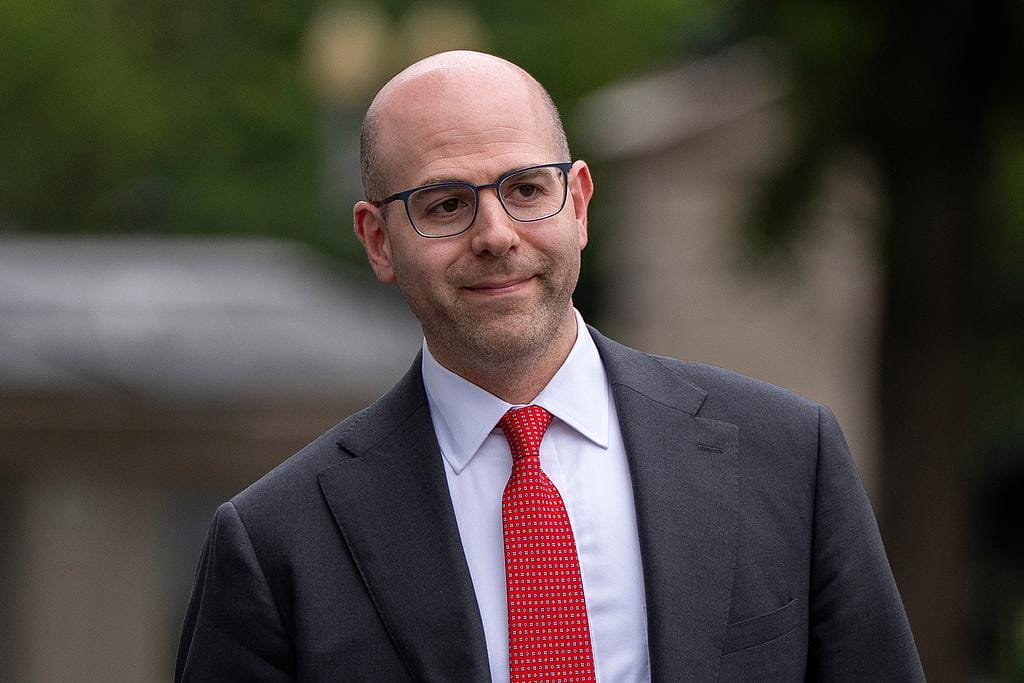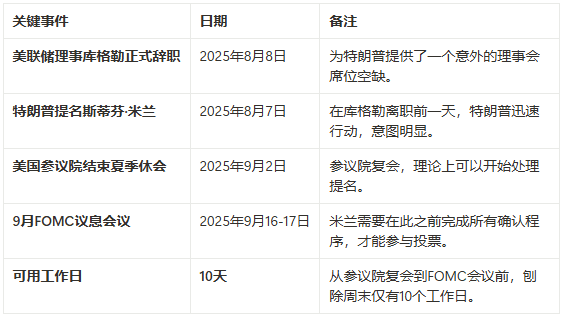Written by: Luke, Mars Finance

On the macroeconomic chessboard, global markets' attention was once focused like a spotlight on one point: whether the U.S. economic data in September could pave the way for a Federal Reserve rate cut. Traders analyzed every employment report and inflation index as if interpreting an oracle, and the core contradiction on Wall Street seemed to simplify into a mathematical problem about 'economic recession' versus 'inflation resilience.'
However, just at the beginning of August, a sudden political variable, like a 'stranger' walking in through the door, instantly changed the nature of the game. The unexpected resignation of Federal Reserve Governor Adriana Kugler and Trump's immediate nomination of his economic advisor Stephen Miran on August 7th to take over suddenly escalated the core contradictions in the market.
The question is no longer merely whether 'economic data supports rate cuts,' but whether 'the president's political will can override the established procedures of the Federal Reserve.' This 'stranger' named Stephen Miran brings not only short-term volatility to the market but, more importantly, carries with him a set of radical ideas that could fundamentally rewrite the rules of the game for the Federal Reserve and the dollar system.
An impossible 'fire line appointment'
The initial market unrest stemmed from an extremely subtle time lag. Trump hopes Miran can quickly enter the Federal Reserve and cast the crucial vote for a rate cut at the FOMC meeting on September 17. However, the institutional gears of American politics turn far more slowly than politicians expect.
Let's first take a look at this nearly infallible timeline:

Completing the full confirmation process for a Federal Reserve governor in just 10 working days— including the Senate Banking Committee's background check, hearings, committee votes, and finally submitting for debate and a vote in the full chamber— is nearly an impossible task in modern American politics. According to data from the Brookings Institution, the average confirmation process for government nominations during Trump's second term has reached a record 94 days.
Moreover, Democratic leaders on the Senate Banking Committee, such as Elizabeth Warren, have publicly labeled Miran as 'Trump's loyalist' and expressed serious concerns about his policy proposals, indicating that they will use all procedural tools to delay this process.
Therefore, the first and most superficial conclusion about this event is already clear: Stephen Miran is almost certain to not be able to vote at the September meeting. The direct impact of this event on the rate cut in September is negligible.
So, if it is not to influence the September rate decision, what is Trump's real deep calculation in playing this card so eagerly? The answer lies within Stephen Miran himself and the ideas he represents.
Miran's 'arsenal': he wants to transform more than just interest rates
Labeling Stephen Miran simply as 'Trump's man' or 'dove' seriously underestimates his energy and the disruptive nature of his ideas. He is not a mere policy executor but an economic thinker with a systematic worldview, a 'designer' attempting to reconstruct the system from the ground up.
His resume is impressive, with a PhD in Economics from Harvard, mentored by the renowned economist Martin Feldstein from the Reagan era. Before entering the White House, he not only had key experiences at the Treasury Department but also served as the global macro strategy head at the well-known hedge fund Hudson Bay Capital. This indicates that he understands both theory and the market.
His real danger is reflected in the two sets of core ideas he has publicly expressed:
First, he advocates fundamentally 'transforming' the Federal Reserve. In co-authored articles, Miran sharply criticizes the Federal Reserve's 'groupthink' that has led to serious policy mistakes in the past. His proposed reform plan is radical: placing the independence of the Federal Reserve beneath the 'will' of the president, granting the president easier power to dismiss governors, and even bringing its budget under Congressional appropriation control. This is no longer a policy route dispute but an attempt to dismantle the Federal Reserve as an independent central bank, a 'century-old institution.'
Secondly, he possesses a complete theory of 'weaponizing the dollar.' In his widely circulated paper (User's Guide to Restructuring the Global Trade System), Miran systematically elaborated on how to use tariffs and exchange rates as weapons to reshape the global trade landscape. He believes that the overvaluation of the dollar is the root cause of the decline of American manufacturing and has conceptualized 'Mar-a-Lago Accord 2.0,' advocating for the proactive depreciation of the dollar through multilateral or even unilateral means. His toolbox includes not only using tariffs as core negotiation chips but also options such as levying 'usage fees' on foreign-held U.S. Treasury bonds, which are of 'nuclear weapon' level.
When these ideas combine with the potential identity of a Federal Reserve governor, a disturbing picture emerges: what Trump wants may be far more than just a few interest rate cuts. He wants a Federal Reserve that can implement his political will, deeply intertwine monetary policy with the trade war, and even shake the credibility of the dollar to achieve his economic goals.
A three-birds-with-one-stone strategy and the 'institutional hedging' moment of Bitcoin
Understanding Miran's core thoughts and the 'impossible timeline,' Trump's move of 'three birds with one stone' becomes clear.
First, this is a short-term pressure tactic on current chair Powell. Even if Miran cannot be in position, this nomination itself is a clear political signal, a public 'knock' on the entire FOMC committee, warning them that they must align their monetary policy with the White House.
Secondly, this is paving a mid-term runway for Miran's competition for the next Federal Reserve chair. Analysts at Barclays Bank pointed out that Miran could become a 'dark horse' for the chair position. Through this nomination, Trump has 'crowned' Miran in front of the world as his most trusted financial advisor, bringing him into the public eye ahead of the battle for the throne after Powell's term ends in 2026.
Finally, this sets a long-term agenda to 'normalize' radical ideas. Throwing Miran's views into the market is itself a test and pressure test. It forces the market to begin discussing and digesting these ideas once deemed 'heretical,' laying the groundwork for potentially more radical policies to be implemented in the future.
And what does all this mean for the crypto world, especially Bitcoin, which is far from the traditional financial system?
For a long time, one of Bitcoin's core narratives has been as 'digital gold' to hedge against inflation. However, when the world's only superpower and the issuer of the global reserve currency openly discusses weaponizing the central bank and national debt, the narrative of Bitcoin's value is quietly elevating.
It is no longer merely a tool to hedge against 'economic risks' (such as inflation) but has become the ultimate tool to hedge against 'institutional risks' and 'political uncertainties.'
The core of this incident lies in the conflict between 'human will' and 'institutional rules.' Miran's theory essentially hopes to place 'the president's will' above the century-old rules of the Federal Reserve. This forms the most vivid contrast in human monetary history with the core principle of the Bitcoin world—'code is law.' The total supply, production speed, and transaction rules of Bitcoin are all enshrined in publicly available, transparent code that is not subject to the interference of any single strongman’s will. This cold, predictable, mathematically certain system is radiating unprecedented appeal in a world where the risks of autocracy are increasingly rising.
When even the safest 'risk-free asset'—U.S. Treasury bonds—can be viewed by their issuer as a tool for levying fees on other countries, global smart money will be forced to rethink the definition of 'risk.' This may drive some of them to seriously consider the asset that is truly independent of any sovereign nation and not subject to any political agenda—Bitcoin.
Thus, the arrival of this 'stranger' Stephen Miran has already provided the strongest narrative for Bitcoin as an 'institutional hedging' tool, regardless of whether he ultimately sits at the Federal Reserve's decision-making table. This may be the most profound signal worth our reflection behind this political game in Washington.


